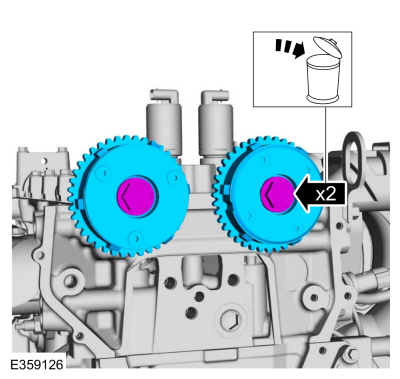Ford Ecosport: Four-Wheel Drive Systems / Description and Operation - Four-Wheel Drive Systems - Overview
The AWD system consists of the following:
- Power Transfer Unit (PTU)
- Rear driveshaft
- AWD relay module
- Rear axle with coupling device
Torque from the engine is transferred through the transmission to the Power Transfer Unit (PTU). This torque is transferred from the driveshaft to the rear axle, which drives the rear halfshafts. The AWD system, also referred to as an Active Torque Coupling (ATC) system, is always active and requires no driver input.
The AWD system continuously monitors vehicle conditions and automatically adjusts the torque distribution between the front and rear wheels. During normal operation, most of the torque is delivered to the front wheels. If wheel slip between the front and rear wheels is detected, or if the vehicle is under heavy acceleration, the AWD system increases torque to the rear wheels to prevent or control wheel slip. When the AWD system is functioning properly, there should be no perceived speed difference between the front and rear axles when launching or driving the vehicle on any uniform surface. Traction should be similar to a part time 4WD system in 4H (4X4 HIGH), but have no binding in turns.
Serviceable components of the Power Transfer Unit (PTU) are limited to the output shaft seal and flange, intermediate shaft seal and deflector, and the Power Transfer Unit (PTU) transmission compression seal. No internal components are serviced. There should be no need to remove the Power Transfer Unit (PTU) cover. If any of the internal geared components, bearings, case cover or shafts are worn or damaged, a new Power Transfer Unit (PTU) must be installed.
 Description and Operation - Four-Wheel Drive Systems - System Operation and Component Description
Description and Operation - Four-Wheel Drive Systems - System Operation and Component Description
System Operation
System Diagram
Item
Description
1
PCM
2
HS-CAN
3
Active Torque Coupling (ATC) solenoid (integral to the Rear Drive Unit (RDU)
4
BCM
5
IPC
6
RCM
7
ABS module
8
HS-CAN
9
HS-CAN
10
..
Other information:
Ford Ecosport 2014-2025 Service and Repair Manual: Removal and Installation - Front Door Lock Control Switch
Removal NOTE: LH side shown, RH side similar. Remove the front door trim panel Refer to: Front Door Trim Panel (501-05 Interior Trim and Ornamentation, Removal and Installation). Remove the front door lock control switch. Release the front door lock control switch retaining tabs. Remove the front door lock control swit..
Ford Ecosport 2014-2025 Service and Repair Manual: Description and Operation - Evaporative Emissions - System Operation and Component Description
System Operation System Diagram Item Description 1 Valve cover 2 Air Cleaner (ACL) outlet pipe 3 Vapor ejector 4 EVAP (Evaporative Emission) canister purge valve 5 Intake manifold 6 PCV (Positive Crankcase Ventilation) valve 7 EVAP canister 8 Fuel vapor v..


